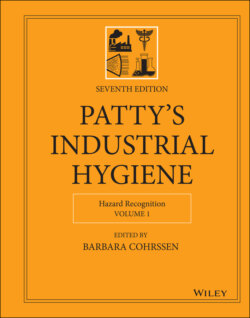Читать книгу Patty's Industrial Hygiene, Hazard Recognition - Группа авторов - Страница 120
5 MULTIDISCIPLINARY RISK COMMUNICATION
ОглавлениеWith the variety of CB models now available for each of the EHS professions, the opportunity to integrate these qualitative risk assessment approaches became the next step toward providing as standardized, multidisciplinary risk communication language. All involved parties in a given workplace incorporate a graded approach mindset that can also be translated into a risk matrix approach as in Figure 3, offering an outcome of a traditional hierarchy of controls in order to provide a consistent hazard elimination process to mitigate employee risk. Tasks with an RL1 designation outcomes are primarily work performed by the general public and a common‐sense procedure approach is presumed. Tasks with an RL2 designation are commonly performed by industry; however, they may require certain standardized controls to ensure a satisfactory reduction of work‐related risk. If regulatory compliance is a component of ensuring this risk reduction, then RL2 tasks do require some level of documentation that these controls are consistently in place and a supervisor's record of these tasks in a designated logbook can work well. EHS professionals can also audit these activities on occasion with the supervisor during workplace visits, ensuring work performed is within the scope and established controls are in place.
As RL1 and RL2 activities are most often made up of standardized tasks that pertain to a given profession or industry, this cost‐effective method ensures EHS regulatory compliance by focusing on risk (32). RL1 and RL2 activities also afford workers an opportunity to take credit for their training and job‐specific expertise while minimizing EHS involvement. The RL3 designation is for work relating to either a higher level of potential risk, including potential regulatory noncompliance, or inappropriately characterized exposure potential. RL3 tasks would require the involvement of an EHS professional to certify with a higher level of control documentation, using a standardized one‐page signed “permit” as an example, in justifying the identified controls will satisfactorily reduce risks. For primarily safety‐related risks, such as roof work, confined space entry, welding, or other hot work activities, the permit ensures that potential risks are addressed, controls are in place, and the worker's training is commensurate to the task. For health‐related risks, such as potential chemical exposure requiring respirators in addition to other standardized personal protection equipment (or personal protection equipment (PPE), such as glove selection, clothing, hearing protection, etc.), the permit can also serve as a regulatory compliance document. Health‐related permits include tasks with potential exposures to asbestos, lead, silica dust, carcinogens, and other common industrial tasks or maintenance and support activities. The commonly used construction site checklist is a good example of health, safety, and often environmental RL3 potentials hazards compiled on one list; if the commensurate controls are in place and checked off the list, then the hazards become a documented RL2 outcome. RL4 tasks are for the highest risk tasks and will require the expert advice of one or more EHS professionals in consultation with workers and possibly management to ensure all job hazards are identified, controlled, and documented.
